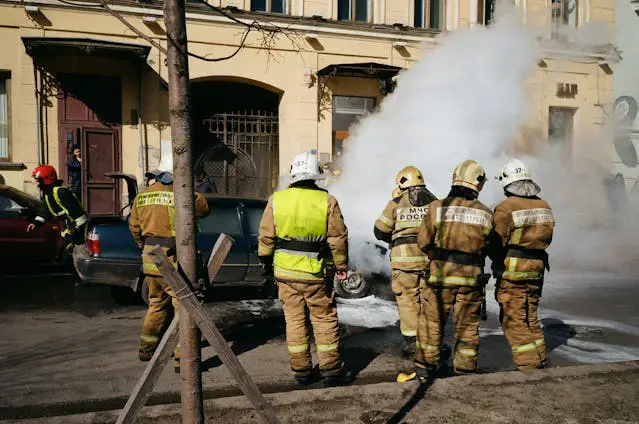
The bystander effect is a phenomenon where individuals fail to help someone in need when other people are present.
This phenomenon is often observed in emergency situations, such as crimes, accidents, or medical emergencies, where the presence of others seems to discourage people from intervening. In this article, we will explore the bystander effect, its causes, and how to overcome it.
What is the Bystander Effect?
The bystander effect is a social phenomenon where individuals are less likely to intervene in an emergency situation when others are present.
It was identified by psychologists Bibb Latané and John Darley in the 1960s, following the tragic case of Kitty Genovese’s murder in New York City.
Factors like diffusion of responsibility and social influence contribute to this phenomenon.
Understanding the bystander effect highlights the importance of recognizing social dynamics in shaping behavior and encourages proactive intervention in emergencies.
- Read also: What is Biopsychology? Demystifying the Mind-Body Connection
- Read also: What is Avolition? Exploring the Impact of Lack of Motivation

Why Does it Happen?
The bystander effect occurs for a couple of key reasons, both related to how we perceive a situation and our social anxieties:
Diffusion of responsibility
When multiple people witness an emergency, the sense of individual responsibility to act gets diluted.
With more bystanders, each person feels less obligated to intervene, assuming someone else will take charge.
This can lead to a situation where everyone waits for someone else to act, and ultimately, no one does.
Pluralistic ignorance
In ambiguous situations, people look to the behavior of others to gauge how to react.
If other bystanders seem calm or uninvolved, it can lead people to believe that intervention isn’t necessary.
This creates a cycle of inaction, where everyone assumes the situation isn’t serious because no one else seems alarmed.
Evaluation apprehension
Fear of judgment can be a powerful inhibitor.
Bystanders might worry about being seen as intrusive, making a scene, or even intervening incorrectly.
This apprehension can lead to inaction, even if the bystander has a strong desire to help.

Real-World Examples
Witnessing a crime
Imagine walking down a busy street and witnessing a theft or assault unfold before your eyes.
Despite recognizing the urgency of the situation, you might hesitate to call the police or intervene, especially if there are other bystanders around.
The presence of others can create a diffusion of responsibility, leading you to assume that someone else will take action, resulting in a delayed or nonexistent response.
Medical emergency
If you encounter someone collapsing on the street in need of medical assistance, the bystander effect might come into play.
Despite your instincts urging you to help, you might pause, unsure if you should intervene or if someone else will step forward.
This hesitation, influenced by the presence of other bystanders, can delay critical medical attention and exacerbate the situation.
Domestic violence
In cases of domestic violence, neighbors may hear yelling or suspicious noises coming from a nearby apartment.
However, the bystander effect might prevent them from calling the police or intervening, as they may question the severity of the situation or fear repercussions from getting involved.
This reluctance to act can perpetuate the cycle of abuse and undermine efforts to support victims.
The spread of misinformation
In today’s digital age, the bystander effect extends to online interactions, particularly on social media platforms.
When individuals witness others sharing misinformation or false rumors, they may passively follow suit without fact-checking or critically evaluating the information.
This perpetuation of misinformation is fueled by the belief that others have already verified its accuracy, leading to the rapid spread of falsehoods.
Online harassment
Similar to cyberbullying, the bystander effect can discourage individuals from speaking up against online harassment directed at others.
When witnessing abusive or offensive behavior in online communities, bystanders may refrain from intervening or reporting the harassment, fearing backlash or social ostracization.
This inaction enables the continuation of harmful behavior and contributes to a toxic online environment.

Overcoming the Bystander Effect
Overcoming the bystander effect requires understanding its causes and developing strategies to counteract them.
Here are some ways to overcome the bystander effect:
Recognize the bystander effect
Acknowledging the existence of the bystander effect is the first step toward overcoming it.
It’s a common social phenomenon where people hesitate to act, often assuming someone else will step in.
Recognizing that everyone can experience this hesitation helps in addressing it without feeling isolated or judged.
By being aware of this tendency, you can consciously work against it.
Take responsibility
Shifting from a bystander mentality to a responsible helper mindset is essential.
Often, people wait for others to act first, which leads to inaction.
Understanding that you have the power to make a difference, even through small actions, can be transformative.
Embrace a proactive approach where you decide to be the person who steps in.
Notice the emergency
Being aware of your surroundings is critical.
Many times, emergencies go unnoticed because people are distracted or not paying attention.
Developing a habit of being observant can help you recognize when something is wrong.
Pay attention to unusual behaviors, distress signals, or calls for help.
Define it as an emergency
Not all situations are clear-cut emergencies.
Sometimes, the seriousness of a situation is ambiguous.
It’s important to assess and acknowledge the potential for harm or the need for assistance.
If you’re unsure, it’s better to err on the side of caution and treat it as an emergency.

Decide to take responsibility
Overcome the diffusion of responsibility, where each bystander assumes someone else will act.
Decide that you will be the one to intervene.
This commitment can break the collective inertia and prompt others to follow suit.
Remember, your decision to act can inspire others to do the same.
Develop a plan to help
Once you’ve decided to take action, think about the safest and most effective way to assist.
This could involve calling emergency services, directly intervening if safe, or delegating tasks to others.
Having a plan reduces hesitation and increases the likelihood of a successful intervention.
Do something
Taking action is the most crucial step.
This could be calling 911, offering direct assistance, or coordinating with other bystanders to help.
Even if you’re unsure of the best course of action, doing something is better than doing nothing.
Your efforts could be life-saving.
Trust your gut
Intuition is a powerful tool. If something feels wrong, it probably is.
Don’t dismiss your instincts.
Acting on your gut feeling can lead to timely intervention in critical situations.
Trusting your intuition can help you overcome doubts and take necessary action.
Be assertive
Don’t be afraid to speak up or take charge in a situation where others are hesitant.
Assertiveness can cut through the confusion and prompt others to take action.
Your leadership in such moments can be crucial, and sometimes, all it takes is one person to lead the way.
Empower others
Encouraging those around you to get involved creates a collective effort that is more effective.
When people see someone taking charge, they are more likely to follow.
By empowering others, you foster a community of active bystanders ready to assist in emergencies.

- Read also: Sitting is the New Smoking: What is Sedentary Behavior
- Read also: Unlocking the Secrets: What is Social Perception?
Conclusion
The bystander effect is a complex phenomenon that can have serious consequences.
Understanding its causes and developing strategies to overcome it can help us become more proactive in emergency situations.
By recognizing the bystander effect and taking steps to overcome it, we can create a more supportive and responsive community.


